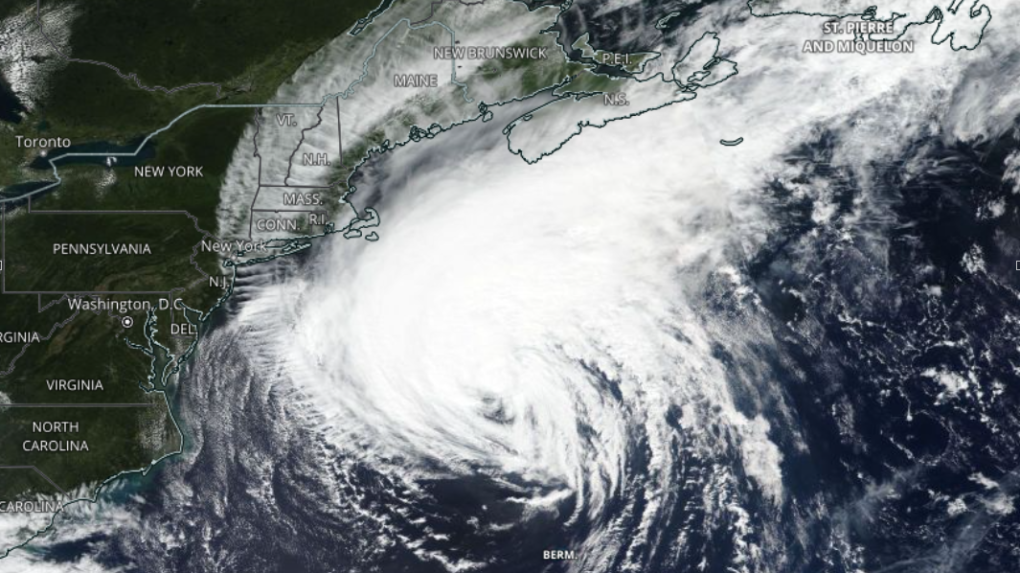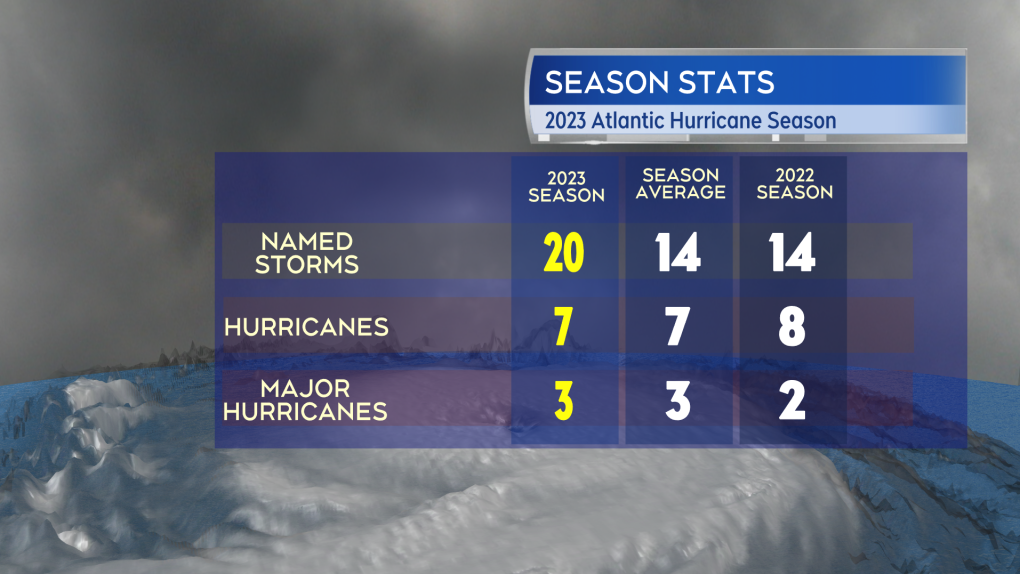2023 Atlantic hurricane season ends; finishes 4th for most-named storms
 NASA satellite imagery showing an approaching Lee moving northward past Bermuda. Lee would eventually make landfall in the southwest of Nova Scotia as a post-tropical storm on Sept. 16.
NASA satellite imagery showing an approaching Lee moving northward past Bermuda. Lee would eventually make landfall in the southwest of Nova Scotia as a post-tropical storm on Sept. 16.
The 2023 Atlantic hurricane season comes to an end on Thursday.
The National Oceanographic and Atmospheric Association of the United States says in a statement they rank the season as fourth for most-named storms in a year.
The final tally includes 20 named storms, seven of which obtained hurricane strength, and three of those seven became a major hurricane, which is defined as Category 3 or higher.
 Hurricane Lee was the only one to impact the Maritimes. Lee made landfall as a strong post-tropical storm on Sept. 16. Not nearly as destructive as Fiona a year prior, there were nonetheless associated power outages and instances of localized flooding due to heavy rain with Lee. The region also had some weather contributed by the remnants of tropical storm Phillipe. Phillipe became post-tropical well to the south of the Maritimes, but, with the remnants combining with a weather front out of the west, moved through as some heavy rain and gusty winds Oct. 7 into 8.
Hurricane Lee was the only one to impact the Maritimes. Lee made landfall as a strong post-tropical storm on Sept. 16. Not nearly as destructive as Fiona a year prior, there were nonetheless associated power outages and instances of localized flooding due to heavy rain with Lee. The region also had some weather contributed by the remnants of tropical storm Phillipe. Phillipe became post-tropical well to the south of the Maritimes, but, with the remnants combining with a weather front out of the west, moved through as some heavy rain and gusty winds Oct. 7 into 8.
 NASA satellite imagery showing an approaching Lee moving northward past Bermuda. Lee would eventually make landfall in the southwest of Nova Scotia as a post-tropical storm on Sept. 16.
NASA satellite imagery showing an approaching Lee moving northward past Bermuda. Lee would eventually make landfall in the southwest of Nova Scotia as a post-tropical storm on Sept. 16.
Initially forecast to be a near-normal season in May, that was revised in August to be an active season expected by the NOAA. The reason for the revisions given was the presence of much warmer than normal ocean waters and lower wind shear. Warmer ocean waters made more energy available to developing storms and lower wind shear allowed those storms to develop the structure necessary to sustain themselves long enough to become tropical storms or hurricanes.
This was a bit of surprise as in a typical El Nino year enough wind shear over the Atlantic is often produced to help restrict the development of tropical storms and hurricanes. In fact, Matthew Rosencrans, lead hurricane forecaster at the NOAA, noted “the Atlantic basin produced the most named storms of any El Nino influenced year in the modern record.”
 The list of names used for the tropical storms and hurricanes of the 2023 Atlantic hurricane season.
The list of names used for the tropical storms and hurricanes of the 2023 Atlantic hurricane season.
The 2024 Atlantic hurricane season will begin on June 1, 2024. The NOAA will likely have their first prediction for that season issued around May 25, 2024.
CTVNews.ca Top Stories

DEVELOPING Jasper wildfire burns buildings, while poor air quality forces some fire crews out
A fast-moving wildfire has hit Jasper, Alberta, destroying buildings and chasing some wildland firefighters away with dangerously poor air quality.
Jasper mayor says alert system to be reviewed after message 'glitch'
More than 25,000 people have been displaced from Jasper National Park since wildfires started to threaten the picturesque corner of Alberta Rockies on Monday, but the mayor of its namesake municipality says not everyone received an evacuation alert when it was sent out.
Norad intercepts Russian and Chinese bombers operating together near Alaska in apparent first
The North American Aerospace Defence Command (Norad) intercepted two Russian and two Chinese bombers flying near Alaska Wednesday in what appears to be the first time the two countries have been intercepted while operating together.
Biden explains why he ended re-election bid in Oval Office address
U.S. President Joe Biden on Wednesday delivered a solemn call to voters to defend the country's democracy as he laid out in an Oval Office address his decision to drop his bid for reelection and throw his support behind Vice President Kamala Harris.
Barrie-Innisfil MPP 'blacked-out' and crashed car into window of child care centre
Staff at a Barrie child care centre say they are frustrated by what they call a local MPP's inadequate response after a car crashed through a window in one of the toddler rooms.
Alberta calls in army to assist with wildfire situation
Alberta has called in the Canadian Armed Forces to help assist with the worsening wildfire situation in the province.
2 Canadians being 'sent home immediately,' removed from Olympic team after drone incident
An analyst and an assistant coach with Canada Soccer are being removed from the Canadian Olympic Team and 'sent home immediately,' according to the Canadian Olympic Committee.
An unwelcome attendee has joined the Paris Olympic Games: COVID-19
After a handful of Australian water polo players tested positive for COVID-19 this week, questions have emerged around how the spread of the disease will be mitigated at the Summer Olympic Games in Paris.
Vacations, meals, booze: Contractor used $100K of charity's money for personal expenses, B.C. court finds
A B.C. man who was hired to help a non-profit build a food hub but instead spent the money on personal expenses – including travel, restaurants, booze and cannabis – has been ordered to pay more than $120,000 in damages.

































